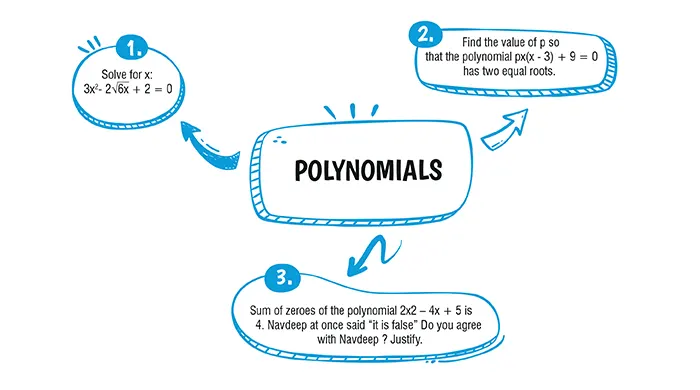Table of Contents

Ans. (b)
Explanation:
Let p(x) = x^2 + 3x + k
∵ x = 2 is a zero of p(x)
∴ p(2) = 0
⇒ (2)^2 + 3(2) + k = 0
⇒ 4 + 6 + k = 0
⇒ 10 + k = 0
⇒ k = -10
(a) -3,2
(b) -3 -2
(c) 3, 2
(d) 3, -2
Ans. (d)
Explanation:
f(x) = x^2 + x - 6 \\
\space\space\space\space\space\space\space = x^2 - 3x + 2x - 6
= x(x - 3) + 2(x - 3)
= (x + 2)(x - 3)
To find zeros put f(x) = 0
∴ x = -2, 3
Explanation:
Given, 3x^2 – 2\sqrt{6x} + 2 = 0 \\ [4 bp]
\Longrightarrow 3x^2 – \sqrt{6x} – \sqrt{6x} + 2 = 0 \\ [4 bp]
\Longrightarrow \sqrt{3x}(\sqrt{3x} – \sqrt{2}) – \sqrt{2}(\sqrt{3x} – \sqrt{2}) = 0 \\ [4 bp]
\Longrightarrow (\sqrt{3x} – \sqrt{2}) – (\sqrt{3x} – \sqrt{2}) = 0 \\ [4 bp]
\Longrightarrow x = \sqrt{\frac{2}{3}}, \sqrt{\frac{2}{3}}
Explanation:
Given,
px(x - 3) + 9 = 0 \\ [4 bp]
\text{or} \space\space\space\space px^2 - 3px + 9 = 0 \\ [4 bp]
Let ⍺, β be the zeroes of the polynomial.
Then, \alpha + \beta = 3 and \alpha \beta = \frac{9}{p} \\ [4 bp]
\text{Also,} \alpha = \beta \\ [4 bp]
\therefore 2\alpha = 3 \\ [4 bp]
\text{or} \alpha = \beta = \frac{3}{2} \\ [4 bp]
\therefore \frac{9}{4} = \frac{9}{p} \\ [4 bp]
\Longrightarrow p = 4 \\ [4 bp]
Hence, the zeroes of the polynomial px(x - 3) + 9 = 0 will be equal when p = 4.
Explanation:
Yes
On comparing the given equation with ax^2 + bx + c,
We get
Here a = 2, b = -4, c = 5
Download Mind Map of this chapter
Download NowWant to Practice Mock Tests of this chapter
Practice NowDownload Important Questions of this chapter
Download Now| Chapter No. | Chapter Name |
|---|---|
| Chapter 1 | Real Numbers |
| Chapter 2 | Polynomials |
| Chapter 3 | Pair of Linear Equations in Two Variable |
| Chapter 4 | Quadratic Equations |
| Chapter 5 | Arithmetic Progressions |
| Chapter 6 | Triangles |
| Chapter 7 | Coordinate Geometry |
| Chapter 8 | Introduction to Trigonometry |
| Chapter 9 | Some Applications of Trigonometry |
| Chapter 10 | Circles |
| Chapter 11 | Areas Related to Circle |
| Chapter 12 | Surface Areas and Volumes |
| Chapter 13 | Statistics |
| Chapter 14 | Probability |
| Chapter Wise Important Questions for CBSE Board Class 10 Maths |
|---|
| Real Numbers |
| Polynomials |
| Pair of Linear Equations in Two Variables |
| Quadratic Equations |
| Arithmetic Progressions |
| Triangles |
| Coordinate Geometry |
| Introduction to Trigonometry |
| Some Applications of Trigonometry |
| Circles |
| Areas Related to Circles |
| Surface Areas and Volumes |
| Statistics |
| Probability |
CBSE Important Questions Class 10
ICSE Important Questions Class 10
CBSE Important Questions Class 10
ICSE Important Questions Class 10